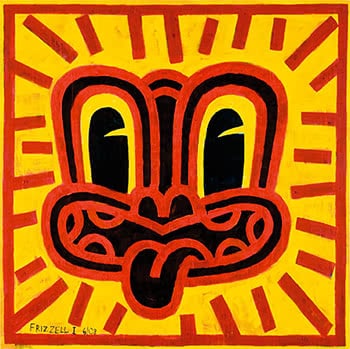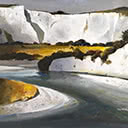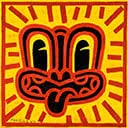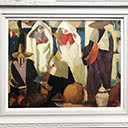Red Haring I
160 x 160 cm
est. $45,000 - 65,000
 Relative size
Relative size
Illustrated: p. 260 Dick Frizzell - The Painter Live Clean & Let Your Works be Seen Godwit 2009
Frizzell's Red Haring I is a gleeful example of pop art at its best. With cartoon eyes twinkling and thick red striations indicating vigorous movement, the tiki, with a maniacal smile, practically bursts from the canvas with enthusiasm. Following on from the infamous Tiki works and forming an integral part of the Red Haring series, this painting unites many of the characteristics considered quintessentially Frizzellian. Frizzell has returned to this series periodically since his 1992 Gow Langsford Tiki exhibition. Renowned for the controversy they aroused during their first showing, the works have long provided the artist a foundation from which to tackle a range of artistic influences and stylistic challenges. From Pablo Picasso and Georges Braque to Alexander Archipenko, Frizzell's Tiki works most commonly reflect the style of the twentieth century's cubists.
However, in Red Haring I the artist selects a rather different master to mimic, drawing, in both style and title, from the work of pop artist Keith Haring. Haring, active in New York during the 1980s, employed canvas, wood, vinyl and inner city subway tunnels with equal pleasure in his work. He achieved global recognition for his cartoon and animation-style figures characterised by bright colours, bold delineation and vivacious characters.
It is easy to see how Haring's aesthetic could appeal to Frizzell who has aligned himself with pop culture for the majority of his career, bringing much-loved personalities from his time in the advertising industry into his paintings and editions with relish. Frizzell has also often utilised cartoons and comic books as a source of inspiration, as seen in both his long-running Phantom series and in the From Mickey to Tiki edition. Like Frizzell, Haring saw no need to differentiate between commercial art and fine art, enthusiastically extracting inspiration from each.
In typical Frizzell style, this work's apparent simplicity in fact relies upon a carefully constructed composition. The tiki's head, mouth, nose and eyes are painted with the same rounded smoothness, the shapes echoing and bouncing off one another, enhancing the work's lively, playful impression with every curve.
Frizzell replicates the bright acid yellow and vermillion used by Haring in some of his most iconic works. Conveying jubilation and energy, such colours are also important tools of the advertising trade through which an everyday commodity can be given renewed appeal and, ideally, fill consumers with the irresistible desire to buy now. This multifaceted work therefore not only recalls pop and graphic art but also becomes a wry caricature of the way in which the tiki, once principally a sacred symbol for Maori, has in many ways become a symbol of commercial tourism in New Zealand.




